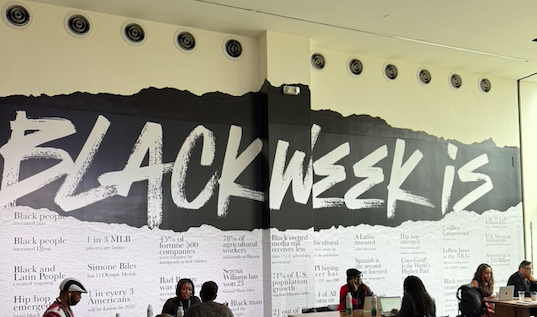
Op-Ed: Your Company’s Stance on WFH Might Be One of the Most Important Policies Impacting Your Well-Being
My dream is for every black and brown professional to experience the work environment that best supports their mental well-being.

By Cameron Jackson, Founder of Thrivency
What’s an employee benefit that’s been most impactful for you? Parental leave, in-office snacks, or maybe wellness stipends? The modern workplace has evolved with employee well-being in mind, often with the goal that employers will differentiate themselves from competitors and retain high-performing team members long-term. But as we’ve collectively stumbled through rebuilding post-pandemic life, return-to-office (RTO) policies have become one of the most important strategies impacting employee well-being.
For any professional browsing LinkedIn Jobs nowadays, they’ll notice three key pieces of information in the listing preview: 1) the title of the open position, 2) the company hiring for the position, and 3) the location where that applicant will be expected to work. In the Future of Recruiting 2024 report published by LinkedIn, data shows that “50% of talent professionals say requiring workers to be in the office full-time is hurting their ability to recruit.” Whereas, 77% of recruiters say that when employees can have hybrid or remote work arrangements, that policy has a positive impact. From updated insights published by LinkedIn in February 2025, 44% of job searchers said that flexible work arrangements are a top-factor they prioritize when considering a job.
It’s no secret that workplace flexibility is a highly-desired policy for job searchers, even if it bucks the corporate tradition of putting in face time with senior leaders and participating in water cooler talk to form connections with co-workers. But what if you’re one of the only people of color on your team? Do the same rules of engagement apply? And, how does the quest for said social capital impact your experience and well-being?
For a moment, let’s turn the time back to the earlier years of the pandemic–a time fraught with confusing RTO mandates.
Less Focus on Office Politics
Back in 2022, a new Harris Poll survey explored employee sentiment, especially as companies stumbled through the decision making process on RTO policies and office space investments. In this analysis, they highlighted that “63% of Black workers and 58% of women say they feel more ambitious when working from home versus the office.” Perhaps the most poignant takeaway was shared by the CEO of Harris Poll, John Gerzema, who said that “It's output over office politics. It's the theater of the office that is often alienating women workers, workers of color, women of color."
Better Control Over Image
In a 2022 op-ed for the LA Times, Eugene Robinson shared that limiting his perception to a laptop screen was actually freeing. He wrote “In real life I am 6-foot-1 and 220 pounds. On a Zoom call, I am about an inch tall and just as wide across. Physicality: gone.”
When thinking more broadly about all of the ways an employee can dress or wear their hair, a very visible expression of one’s cultural background, these factors can lead to uncomfortable in-person interactions or influence the perception of one’s office mates. By neutralizing these factors, it’s no wonder that certain employees feel a certain level of freedom–probably due to less monitoring and policing of expression.
What Does Research Say? The Pros and Cons of WFH
Although post-covid research on the impact of WFH on well-being has been surprisingly scant, several analyses reveal a list of potential pros and cons for employees working from home:
Pros:
- Employees gain perceived job autonomy and work schedule flexibility (source: Wells, Scheibein, etc. 2023).
- In one study, 56% of workers said WFH was better for their mental health, while 43% reported that hybrid work was best (source: FlexJobs).
- Remote employees save an estimated $600 to $6K a year by cutting costs on travel, parking, and food (source: Global Workplace Analytics).
- Professionals who WFH reported healthier lifestyle choices, including cooking healthier meals or exercising more regularly (source: Global Workplace Analytics).
Cons:
- Nearly two-thirds of people working from home reported feeling isolated or lonely at least sometimes and 17% do all the time (source: American Psychiatric Association). Process this with the caveat that this data was gathered in 2020-21, a time when most outside of work socialization was limited.
- Most employees’ home offices or work spaces are not equipped with ergonomic office chairs, resulting in a number of ailments (source: Wells, Scheibein, etc. 2023).
- One study found that 40% of workers feel it’s harder to collaborate with their team on virtual calls (source: Lucid).
- Workers that objectively fall within a lower socioeconomic status (SES) may not experience many of the benefits associated with WFH or even have access to the opportunity (source: Loignon, Johnson, and Boyd. 2022).
Perhaps one of the most important data points to include – who even has the opportunity to work remotely? In a 2022 study by the National Institute for Occupational Safety and Health (NIOSH), data showed that “teleworking has been lower among non-Hispanic Blacks (Black workers) and Hispanics than non-Hispanic Whites (White workers) and non-Hispanic Asians (Asian workers) in the United States.” Why such a discrepancy? The study discovered that 80% of the difference in teleworking between professionals of different racial backgrounds could be explained by differences in four-year college education and occupation.
In Conclusion, It's Not That Simple
Working remotely offers a mixed bag of pros and cons, which could ultimately depend on the foundation upon which an individual employee starts with. If an employee already experiences mental well-being challenges, will it be exasperated by further isolation? What if a remote team member’s ability to perform depends heavily on their environmental well-being and stability at home?
As if this matter weren’t complicated enough, we must also consider the economic conditions we currently find ourselves in. At the time of publishing this article, the U.S. and global economy at large are in flux. As the power balance pendulum within the labor market swings from employee to employer, the freedom to even prioritize hybrid or remote work fades away as companies slow down on hiring and cut costs.
As all of these factors swirl around in my head, I remember a TED Talk I watched by Simone D. Ross, MBA, MA. She boldly starts her talk with the statement “I think Black women are safer working remote.” She goes on to share personal anecdotes of times she toned down aspects of her physical appearance before heading to the office, even as a C-suite executive.
In closing, she adds “I think anybody that is not status quo and can’t come work their authentic selves every day… I think they are safer working remote. As leaders, it’s up to us to create the safety for people to come to work their authentic selves.”
My dream is for every black and brown professional to experience the work environment that best supports their mental well-being, financial stability, and professional efficacy. We know this isn’t the reality throughout much of America, and yet it is our duty to persist anyway. However, my hope is that with access to more information of what your options are, you may move little by little toward what works best for you.
I’d love to hear your thoughts on the matter. Share them below or email us at hello@thrivency.co.
.png)




